Zinc acetate dihydrate
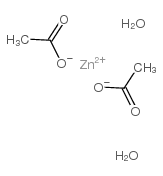
Zinc acetate dihydrate structure
|
Common Name | Zinc acetate dihydrate | ||
|---|---|---|---|---|
| CAS Number | 5970-45-6 | Molecular Weight | 219.49900 | |
| Density | 1.84 | Boiling Point | 242-4°C | |
| Molecular Formula | C4H10O6Zn | Melting Point | 237 ºC | |
| MSDS | Chinese USA | Flash Point | N/A | |
| Symbol |


GHS07, GHS09 |
Signal Word | Warning | |
| Name | Zinc acetate dihydrate |
|---|---|
| Synonym | More Synonyms |
| Density | 1.84 |
|---|---|
| Boiling Point | 242-4°C |
| Melting Point | 237 ºC |
| Molecular Formula | C4H10O6Zn |
| Molecular Weight | 219.49900 |
| Exact Mass | 217.97700 |
| PSA | 98.72000 |
| Storage condition | Store at RT. |
| Stability | Stable. Incompatible with alkalies, strong oxidizing agents. |
| Water Solubility | 430 g/L (20 ºC) |
CHEMICAL IDENTIFICATION
HEALTH HAZARD DATAACUTE TOXICITY DATA
MUTATION DATA
|
| Symbol |


GHS07, GHS09 |
|---|---|
| Signal Word | Warning |
| Hazard Statements | H302-H319-H410 |
| Precautionary Statements | P273-P305 + P351 + P338-P501 |
| Personal Protective Equipment | dust mask type N95 (US);Eyeshields;Gloves |
| Hazard Codes | Xn,N |
| Risk Phrases | 22-36-50/53 |
| Safety Phrases | S26-S60-S61-S36 |
| RIDADR | UN 3077 9/PG 3 |
| WGK Germany | 3 |
| RTECS | ZG8750000 |
| HS Code | 2915299090 |
| Precursor 3 | |
|---|---|
| DownStream 10 | |
| HS Code | 2915299090 |
|---|---|
| Summary | 2915299090 salts of acetic acid。supervision conditions:AB(certificate of inspection for goods inward,certificate of inspection for goods outward)。VAT:17.0%。tax rebate rate:9.0%。MFN tariff:5.5%。general tariff:50.0% |
|
Zinc supplements for preventing otitis media.
Cochrane Database Syst. Rev. 4 , CD006639, (2012) Otitis media (OM) is inflammation of the middle ear and is usually caused by infection. It affects people of all ages but is particularly common in young children. Around 164 million people worldwide ... |
|
|
New structural motifs in lithium and zinc calix[4]arene chemistry.
Dalton Trans. 42(6) , 1983-6, (2013) The structures of three novel compounds prepared from the reaction of the lower-rim 1,3-diacid calix[4]arene (LH(2)) with lithium carbonate (1), t-butyl-lithium (2) and zinc acetate (3) are reported. |
|
|
Influence of trace elements on stabilization of aqueous solutions of ascorbic acid.
Biol. Trace Elem. Res. 150(1-3) , 509-12, (2012) Together with vitamin C, zinc, selenium, manganese, and magnesium play a vital role in the preservation of organs scheduled for transplantation. In the present study, it is shown that addition of 1 mg... |
| EINECS 209-170-2 |
| MFCD00066961 |
| zinc,diacetate,dihydrate |
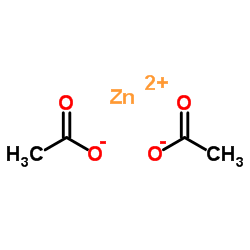 CAS#:557-34-6
CAS#:557-34-6 CAS#:64-19-7
CAS#:64-19-7 CAS#:743369-26-8
CAS#:743369-26-8![Zinc 29H,31H-tetrabenzo[b,g,l,q]porphine structure](https://image.chemsrc.com/caspic/429/14586-52-8.png) CAS#:14586-52-8
CAS#:14586-52-8 CAS#:588-46-5
CAS#:588-46-5 CAS#:7440-66-6
CAS#:7440-66-6 CAS#:31183-11-6
CAS#:31183-11-6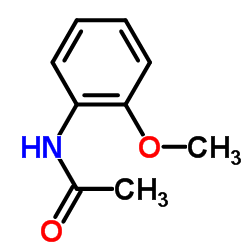 CAS#:93-26-5
CAS#:93-26-5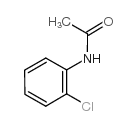 CAS#:533-17-5
CAS#:533-17-5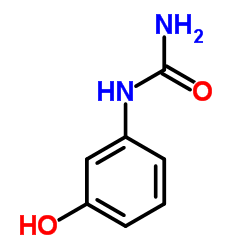 CAS#:621-42-1
CAS#:621-42-1 CAS#:557-05-1
CAS#:557-05-1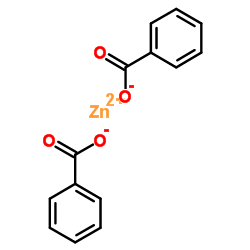 CAS#:553-72-0
CAS#:553-72-0
